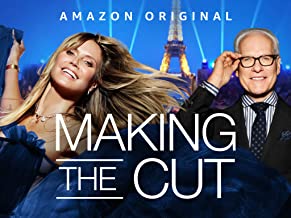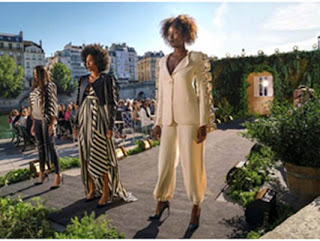Product Description»
It’s not
until the sixth episode of Amazon’s new fashion competition series “Making theCut” that one of its competitors snaps, yelling to no one in particular about
one of his inchoate designs, “I don’t want to make it wearable!” Too bad,
because the new series, a “Project Runway” knockoff that attempts to hide its
obvious inspiration while also trading on the star power of hosts — and former
“Project” faces — Heidi Klum and Tim Gunn, isn’t just about making it
wearable, it’s about making it wearable for everyone.
It’s a
fine enough idea, even a powerful one, but one that doesn’t make much sense in
practice: the show gathers a dozen talented designers together, then tells them
to make clothes ready to sell on Amazon, so that they may win the ultimate
prize, which is to sell an entire line on the behemoth online shopping
platform. Mass consumption doesn’t make for the most eye-catching fashion, and
it doesn’t even make for particularly engaging reality television.
Not that
“Making the Cut” isn’t enjoyable enough, if only because its rules and paces
are readily digestible to an audience that’s long familiar with the formulas
that drive the genre. It’s easy to watch. Yes, there are some differences
between “Making the Cut” and “Project Runway,” and the show is all to happy to
remind viewers of them early and often. Some of them are technical, like that
each episode doesn’t necessarily end with just one person going home or that
the contenders can actually try to convince the judges they should still get to
stay after an initial heave-ho.
Also of
note: all of the show’s contestants have established brands (next to the word
“accessible,” there’s no term bandied about on the series as much as “brand”),
and while they might not be name brands, these people have been
working it for a long time (all of them have their own lines, most of them have
shown at various fashion weeks, some of them have even dressed stars like Nicki
Minaj and Billy Porter).
Fans of
“Project Runway” will also spark to another technical twist: each contestant
gets their own dedicated seamstress (not that we ever meet them), which allows
them to focus on their designs over their craftsmanship. It’s an aces idea, one
that seems to level the playing field while adding in all sorts of other
potential dramas, like “what the hell will my garments look like when they come
back from the seamstress?” and “does it actually matter that I can’t sew?”
Surely “Making the Cut” had to layer on the rule changes to differentiate it
from other shows of its ilk, but while the seamstress rule is perhaps the
smallest, it’s also the one that offers real bang.
And then
there’s that Amazon synergy. The winner of “Making the Cut” will be lavished
with prizes, including not just bragging rights, but also a cool million
dollars, plus an all-new collection launching exclusively on Amazon. That’s not
all, however, because each individual competition’s winning look will also
instantly be available for sale on the online shopping portal. That’s right,
once that winner is announced at the end of each new ep, interested shoppers
can fire up their browsers and smartphones and apps and head on over to the“Making the Cut” store to pick up whatever just won top honors.
It’s all
part of the real aim of “Making the Cut”: to not necessarily find the next
great fashion designer or line, but the next great “global brand.” That spirit
of global inclusion has powerful reach within smaller pockets of the show,
which doesn’t make a big deal about its wide range of models (all sizes, all
genders, all colors, though they remain predominantly young) or its even wider
selection of contestants (again, all sizes, all genders, all colors, even a few
older folks to really jazz it up). That’s a new kind of accessibility, a
welcome kind, but not one that inspires similarly forward-thinking fashion.
In
short, most of the looks are bad, or at least not inventive or thrilling in the
way fashion is expected to be. The bent towards being “wearable” stifles the
designers’ creativity with startling regularity, and siloing it off from more
high fashion looks does nothing to help the concept that fashions should be
(and can be) for all. Most episodes hinge on competitions in which
the contestants are encouraged to craft two looks, one “accessible”
and “consumer-friendly,” the other more fit for the runway, and that division
does little to bring out the best in the show’s creators.
Initially
capped at a cool dozen, the show takes far too long to offer deep insights into
its various competitors. Even in the fifth episode of the show (the first six
were made available to critics for review), contenders were still being
introduced via filmed interviews. Still, there is amusement in watching stars
emerge in seemingly organic ways (like wunderkind Sander, who backs up his big
personality with even bigger talent, or heavy-hitting Esther, who starts strong
and begins to falter), while increasingly wacky challenges push them into more emotional
spaces.
Still,
the seams in the interpersonal drama are visible. It’s a given that reality
programming will twist, well, reality to serve narrative and emotional ends,
but much of that feels manufactured in the “Making the Cut” world. A
contestant who seemed talented and well-adjusted suddenly starts crying during
innocuous confessionals — only to exit the show of his own volition,
leaving everyone (and maybe even the producers) stunned. Another contestant has
a freak-out that warrants a cheap and cheesy flash-forward to all the impending
drama, only for the contender to rein themselves back in and hustle onward
through an episode initially set up to follow a personal implosion that never
comes.
Even
less successful are a series of jaunts — styled, somewhat awkwardly, as dates —
that Klum and Gunn undertake throughout the series. Perhaps intended to shine a
light on the show’s starry settings, as they often include cute cultural
touches (a cabaret in Paris! a robotic restaurant in Tokyo!), the conceit still
can’t help but fall flat, diluting any momentum the competitions have and
padding out episodes that push into the one-hour mark without any commercial
breaks.
At least
some of the judges are able to pick up the dramatic slack, particularly Naomi
Campbell, whose trademark forthright nature is often the blunt force the
contenders need. (Gunn, while not on deck to judge, also seems more free and
easy about delivering tough talk to working designers than he was on “Runway.”)
Despite setting up a stacked panel in its first episode, including Klum,
Campbell, Nicole Richie, Joseph Altuzarra, and Carine Roitfeld, the show later
cycles between them, adding in influencer Chiara Ferragni and, at one point, a
popular animated Japanese character (the winner will have their design posted
on her social media feeds, naturally).
That
kind of strange messiness actually suits the show, which spends more than half
of its first season adhering to worn-out tropes before starting to break out of
old patterns. It starts with that yelled decree about wearability, and it
begins to show itself in amped-up competitions that benefit from designers
throwing out rigid concepts about what to make. Wearable? Maybe. Accessible?
What’s more accessible than the idea that being exactly who you are is actually
the winning answer? Put that on a tee-shirt.
 |
| Buy Amazon Fashion |





















0 Reviews